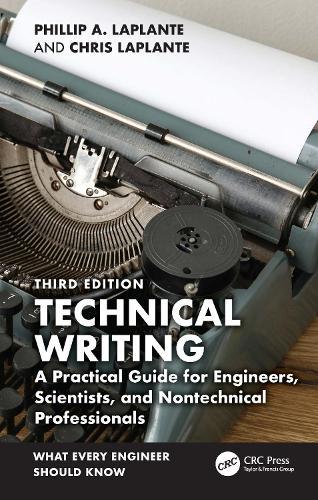Overview
Technical Writing: A Practical Guide for Engineers, Scientists, and Nontechnical Professionals enables readers to write, edit, and publish materials of a technical nature, including books, articles, reports, and electronic media. Written by experienced practicing engineers, this guide complements traditional technical writing manuals through the presentation of firsthand examples that help readers understand practical considerations in writing and producing technical content. These examples illustrate how a publication originates as well as explain various challenges and solutions. The third edition features the following: New and updated exercises, examples, and case studies New content on software/systems documentation Treatment of plagiarism to incorporate issues in generative artificial intelligence (AI), open-access archiving, and more Coverage of popular writing and collaboration tools such as Grammarly, Overleaf, and Google Docs Increased conversation of writing for non-native English speakers Latest standards and research Written in an informal, conversational style, unlike traditional writing texts, this book contains many interesting vignettes and personal stories to add interest to otherwise stodgy lessons. It is aimed at students and professionals in the science and engineering domains.
Full Product Details
Author: Phillip A. Laplante (The Pennsylvania State University, Malvern, USA) ,
Chris Laplante
Publisher: Taylor & Francis Ltd
Imprint: CRC Press
Edition: 3rd edition
ISBN: 9781032843742
ISBN 10: 1032843748
Pages: 257
Publication Date: 25 November 2025
Audience:
College/higher education
,
Professional and scholarly
,
Tertiary & Higher Education
,
Professional & Vocational
Format: Paperback
Publisher's Status: Forthcoming
Availability: Not yet available

This item is yet to be released. You can pre-order this item and we will dispatch it to you upon its release.
Author Information
Phillip A. Laplante, Professor Emeritus of Software and Systems Engineering (Penn State), is internationally renowned for his research, teaching, and service in areas such as artificial intelligence, critical infrastructure systems, image processing, and real-time systems. Phil has more than 40 years of experience as a senior technology leader in development, research, teaching, and administrative roles. He has worked in industry, academia, and government, where he wrote thousands of business communications and technical reports. His publications include 40 books and more than 350 papers in scholarly journals, magazines, conferences, and newsletters. He is the founding editor-in-chief of IEEE Reliability Magazine and the editor-in-chief of three Taylor & Francis book series, and he has served on dozens of editorial boards for other scholarly publications. His work includes definitive texts in requirements engineering, real-time systems, and technical writing. These and many of his other books are used in universities around the world. His recent book Chaos, Fractals, and Dynamical Systems, with Chris Laplante, was written for use in homeschooling. Phil earned a PhD in computer science, an MEng in electrical engineering, and a BS in systems planning and management, all at Stevens Institute of Technology. He also earned an MBA at the University of Colorado at Colorado Springs. He is available for speaking, teaching, and consulting. Chris Laplante was introduced to the BASIC programming language at a very young age by his father, Phil. He quickly became fascinated by programming and computers in general. He is currently a software engineer at Agilent Technologies, where he works on embedded Linux systems for gas chromatographs and automated liquid samplers. He is the coauthor of the book Chaos, Fractals, and Dynamical Systems, with Phil Laplante, and an active contributor to various electronic media sites. He earned a BS in computer science with a minor in mathematics at Penn State.



